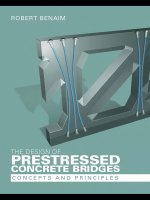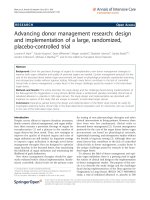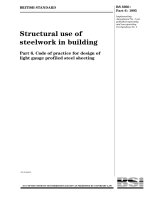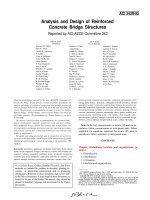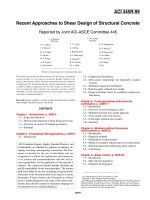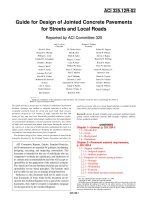Construction management and design of industrial concrete and steel structures
Bạn đang xem bản rút gọn của tài liệu. Xem và tải ngay bản đầy đủ của tài liệu tại đây (8.06 MB, 578 trang )
Construction
Management
and Design of
Industrial Concrete
and
Steel Structures
Construction
Management
and Design of
Industrial Concrete
and
Steel Structures
Mohamed A. El-Reedy, Ph.D.
Consultant Engineer
Cairo, Egypt
Boca Raton London New York
CRC Press is an imprint of the
Taylor & Francis Group, an informa business
CRC Press
Taylor & Francis Group
6000 Broken Sound Parkway NW, Suite 300
Boca Raton, FL 33487-2742
© 2011 by Taylor and Francis Group, LLC
CRC Press is an imprint of Taylor & Francis Group, an Informa business
No claim to original U.S. Government works
Printed in the United States of America on acid-free paper
10 9 8 7 6 5 4 3 2 1
International Standard Book Number-13: 978-1-4398-1600-4 (Ebook-PDF)
This book contains information obtained from authentic and highly regarded sources. Reasonable efforts
have been made to publish reliable data and information, but the author and publisher cannot assume
responsibility for the validity of all materials or the consequences of their use. The authors and publishers
have attempted to trace the copyright holders of all material reproduced in this publication and apologize to
copyright holders if permission to publish in this form has not been obtained. If any copyright material has
not been acknowledged please write and let us know so we may rectify in any future reprint.
Except as permitted under U.S. Copyright Law, no part of this book may be reprinted, reproduced, transmitted, or utilized in any form by any electronic, mechanical, or other means, now known or hereafter invented,
including photocopying, microfilming, and recording, or in any information storage or retrieval system,
without written permission from the publishers.
For permission to photocopy or use material electronically from this work, please access www.copyright.
com ( or contact the Copyright Clearance Center, Inc. (CCC), 222 Rosewood
Drive, Danvers, MA 01923, 978-750-8400. CCC is a not-for-profit organization that provides licenses and
registration for a variety of users. For organizations that have been granted a photocopy license by the CCC,
a separate system of payment has been arranged.
Trademark Notice: Product or corporate names may be trademarks or registered trademarks, and are used
only for identification and explanation without intent to infringe.
Visit the Taylor & Francis Web site at
and the CRC Press Web site at
This book is dedicated to the spirits of my mother and father,
my wife, and my children Maey, Hisham, and Mayar.
Contents
Preface.................................................................................................................... xix
Author.................................................................................................................... xxi
1. Introduction......................................................................................................1
2. Construction Management for Industrial Projects..................................5
2.1 Introduction............................................................................................5
2.2 Project Characteristics...........................................................................5
2.3 Project Life Cycle....................................................................................8
2.3.1 Feasibility Study...................................................................... 10
2.3.2 FEED (Preliminary) Engineering......................................... 11
2.3.3 Detail Engineering................................................................. 14
2.3.4 Design Management.............................................................. 16
2.3.5 Execution Phase...................................................................... 17
2.3.6 Commissioning and Start-Up............................................... 17
2.4 Is This Project Successful?.................................................................. 18
2.5 Project Management Tasks................................................................. 18
2.6 Project Manager Skill.......................................................................... 20
2.7 Project Planning................................................................................... 20
2.7.1 Who Will Make the Plan?......................................................22
2.7.2 Where Do You Start the Plan?............................................... 23
2.7.3 Work Breakdown Structure................................................... 26
2.8 Responsibilities of the Planning Team............................................. 27
2.9 Estimating Time Required for an Activity....................................... 28
2.9.1 Calculating Time Required for an Activity........................30
2.9.2 Time Schedule Preparation...................................................30
2.9.3 Arrow Diagram....................................................................... 31
2.9.4 Precedence Diagram............................................................... 32
2.9.5 Gantt Chart.............................................................................. 32
2.9.6 Critical Path Method.............................................................. 33
2.9.7 Program Evaluation and Review Technique......................34
2.9.8 Example.................................................................................... 35
2.9.9 Applications for the PERT Method...................................... 36
2.9.9.1 Statistical Calculation of Activity Time............... 38
2.9.9.2 Example.................................................................... 38
2.10 Cost Management................................................................................ 39
2.10.1 Cost Estimate........................................................................... 39
2.10.2 Cost Types................................................................................ 41
2.10.3 Construction Cost Estimate...................................................42
2.10.4 Steel Structure Cost Estimate................................................44
vii
viii
Contents
2.10.5
2.10.6
2.10.7
2.10.8
Detailed Cost........................................................................... 46
Tendering Cost Estimate........................................................ 46
Cost Estimate to Project Control........................................... 46
Economic Analysis of Project Cost....................................... 47
2.10.8.1 Work Breakdown Structure................................... 47
2.10.8.2 Organization Breakdown Structure..................... 48
2.10.8.3 OBS and WBS Matrix.............................................. 48
2.10.8.4 Work Packages......................................................... 48
2.10.8.5 Cost Control............................................................. 50
2.10.8.6 The Cost Curve........................................................ 52
2.10.9 Cash Flow Calculation........................................................... 55
2.10.9.1 Cash Flow during the Project................................ 56
2.10.9.2 Impact on Increasing Cost..................................... 57
2.10.9.3 Project Late Impact.................................................. 58
2.10.9.4 Impact of Operation Efficiency............................. 58
2.11 Project Risk Management................................................................... 59
2.11.1 Project Risks............................................................................ 60
2.11.2 Risk Assessment..................................................................... 61
2.11.3 Defining Risk Using Quantitative Risk Assessment......... 62
2.11.4 Qualitative Risk Assessment.................................................64
References........................................................................................................ 66
3. Loads on Industrial Structures................................................................... 67
3.1 Introduction.......................................................................................... 67
3.2 Loads...................................................................................................... 67
3.2.1 Dead Load................................................................................ 68
3.2.1.1 General Design Loads............................................ 68
3.2.1.2 Pipe Rack.................................................................. 75
3.2.1.3 Ground-Supported Storage Tank Loads.............. 76
3.2.2 Live Loads................................................................................77
3.2.3 Wind Loads.............................................................................. 78
3.2.3.1 Basic Wind Load Formula...................................... 78
3.2.3.2 Wind Loads on Pipe Racks and
Open- Frame Structures.......................................... 81
3.2.4 Earthquake Loads................................................................. 103
3.2.4.1 Design Spectral Response Acceleration
Parameters.............................................................. 104
3.2.4.2 Architectural, Mechanical, and Electrical
Components Systems............................................ 104
3.2.4.3 HVAC Ductwork................................................... 107
3.2.4.4 Piping Systems....................................................... 108
3.2.4.5 Boilers and Pressure Vessels................................ 109
3.2.4.6 General Precaution................................................ 109
3.2.4.7 Building and Nonbuilding Structures............... 109
3.2.4.8 Flexibility of Piping Attachments....................... 114
ix
Contents
3.2.4.9 Design Review for Seismic Loads....................... 115
Impact Loads......................................................................... 116
Thermal Loads...................................................................... 116
Bundle Pull Load.................................................................. 117
Ice Loads................................................................................. 118
3.2.8.1 Site-Specific Studies.............................................. 118
3.2.8.2 Loads due to Freezing Rain................................. 119
3.2.8.3 Design Ice Thickness for Freezing Rain............ 120
3.2.8.4 Wind on Ice-Covered Structures........................ 120
3.3 Load Combinations........................................................................... 120
3.3.1 Load Combinations.............................................................. 121
3.3.1.1 Vertical Vessels...................................................... 125
3.3.1.2 Horizontal Vessels and Heat Exchangers.......... 125
3.3.1.3 Pipe Rack and Pipe Bridge Design..................... 126
3.3.1.4 Ground-Supported Storage Tank Load
Combinations......................................................... 126
3.3.2 Test Combinations................................................................ 126
References...................................................................................................... 127
3.2.5
3.2.6
3.2.7
3.2.8
4. Design of Foundations for Vibrating Equipment................................. 129
4.1 Introduction........................................................................................ 129
4.2 Machine Requirements..................................................................... 129
4.3 Foundation Design Guidelines........................................................ 130
4.3.1 Trial Foundation Sizing Guidelines................................... 130
4.3.2 Foundation Dynamic Analysis........................................... 132
4.3.3 Soil Parameter....................................................................... 134
4.4 Vibration Isolation.............................................................................. 146
4.4.1 Isolating Liners...................................................................... 147
4.4.2 Spring and Rubber Mounts................................................. 147
4.4.3 Inertia Block Bolt or Pad Mounting Bolt Installation...... 148
4.4.4 Grouting................................................................................. 149
4.5 Design Checklist................................................................................ 151
References...................................................................................................... 151
5. Storage Tank Design................................................................................... 153
5.1 Introduction........................................................................................ 153
5.2 Concrete Storage Tanks..................................................................... 153
5.2.1 Rectangular Wall—Concrete.............................................. 155
5.2.2 Circular Tank......................................................................... 158
5.3 Retaining Wall.................................................................................... 161
5.3.1 Preliminary Retaining Wall Dimensions.......................... 162
5.3.1.1 Check Stability against Overturning................. 162
5.3.1.2 Check Stability against Sliding........................... 164
5.3.1.3 Check Stability against Bearing Capacity......... 164
5.4 Steel Storage Tank.............................................................................. 167
x
Contents
5.4.1
5.4.2
5.4.3
5.4.4
Tank Capacity........................................................................ 167
Bottom Plates......................................................................... 168
Annular Bottom Plates......................................................... 169
Shell Design........................................................................... 170
5.4.4.1 Allowable Stress.................................................... 171
5.4.4.2 Calculation of Thickness by the
1-Foot Method........................................................ 171
5.4.4.3 Calculation of Thickness by the VariableDesign-Point Method............................................ 172
5.4.5 Roof System........................................................................... 175
5.4.5.1 Allowable Stresses................................................. 177
5.4.5.2 Supported Cone Roofs.......................................... 177
5.4.5.3 Self-Supporting Cone Roofs................................ 179
5.4.5.4 Self-Supporting Dome and Umbrella Roofs...... 179
5.4.6 Tank Design Loads............................................................... 180
5.4.7 Load Combination................................................................ 182
5.4.8 Design Basis for Small Tanks.............................................. 182
5.4.9 Piping Flexibility................................................................... 185
5.4.10 Differential Settlement Tank Bottom Designs.................. 186
5.5 Ring Beam Design Consideration................................................... 187
5.5.1 Wind and Earthquake Stability and Pressures................ 191
5.5.2 Earthquake Stability............................................................. 191
5.5.3 Soil Bearing............................................................................ 191
5.5.4 Soil Pressure (Uplift Is Present).......................................... 192
5.5.5 Concrete Ring Beam Design............................................... 193
5.5.6 Ring Wall Reinforcement..................................................... 194
References...................................................................................................... 198
6. Static Equipment Foundation Design..................................................... 199
6.1 Introduction........................................................................................ 199
6.2 Design Procedure............................................................................... 199
6.2.1 Dead Loads............................................................................ 199
6.2.2 Live Loads.............................................................................. 201
6.2.3 Wind Loads............................................................................ 201
6.2.4 Earthquake Loads................................................................. 201
6.2.5 Bundle Pull Load (Exchangers).......................................... 202
6.2.6 Thermal Forces...................................................................... 202
6.2.7 Load Combinations.............................................................. 206
6.3 Anchor Bolts....................................................................................... 206
6.4 Slide Plates.......................................................................................... 206
6.5 Pier Design.......................................................................................... 208
6.5.1 Anchorage Considerations.................................................. 208
6.5.2 Reinforcement for Piers........................................................ 208
6.6 Foundation Design............................................................................. 209
6.6.1 Foundation Reinforcement.................................................. 210
Contents
xi
6.6.1.1 Bottom Reinforcement.......................................... 210
6.6.1.2 Top Reinforcement................................................ 211
6.7 Example: Heat Exchanger Data........................................................ 214
6.7.1 Design Data........................................................................... 214
6.7.2 Design Criteria...................................................................... 214
6.7.3 Loads Calculation................................................................. 215
6.7.4 Design Elements.................................................................... 217
6.7.4.1 Size Steel Slide Plate.............................................. 217
6.7.4.2 Pier Size.................................................................. 218
6.7.4.3 Pier Design............................................................. 218
6.7.4.4 Footing Size............................................................ 221
6.7.4.5 Footing Design...................................................... 230
6.8 Separator Design Example................................................................ 233
6.8.1 Design Data........................................................................... 233
6.8.2 Loads Calculation................................................................. 235
6.8.3 Design Elements.................................................................... 236
6.9 Vertical Vessel Foundation Design.................................................. 238
6.9.1 Dead Loads............................................................................ 238
6.9.2 Pedestal Design..................................................................... 241
6.9.3 Footing Design...................................................................... 244
6.9.4 Soil Bearing on the Octagon Footing................................. 244
6.9.5 Check Stability and Sliding................................................. 249
6.9.6 Check for Foundation Sliding............................................. 250
6.9.7 Reinforced Concrete Design................................................ 250
6.9.7.1 Top Reinforcement................................................ 251
6.9.7.2 Shear Consideration.............................................. 251
6.10 Example for Vertical Vessel.............................................................. 253
6.10.1 Design Data........................................................................... 253
6.10.2 Pedestal Design.....................................................................254
6.10.3 Anchor Bolt Check................................................................ 255
6.10.4 Footing Design...................................................................... 256
6.11 Pipe Support....................................................................................... 259
References...................................................................................................... 263
7. Steel Structures in Industry...................................................................... 265
7.1 Introduction........................................................................................ 265
7.2 Stress–Strain Behavior of Structural Steel...................................... 265
7.3 Design Procedure............................................................................... 266
7.3.1 Tension Members.................................................................. 267
7.3.1.1 Slenderness Ratio.................................................. 268
7.3.2 Compression Members........................................................ 271
7.3.2.1 Steps of Preliminary Design................................ 271
7.3.3 Beam Design.......................................................................... 281
7.3.3.1 Lateral Torsion Buckling...................................... 283
7.3.3.2 Allowable Deflection............................................ 285
xii
Contents
7.3.4
Design of Beam Column Member (Allowable
Stress Design)........................................................................ 290
7.3.5 Design of Beam Column Member (LRFD)........................ 292
7.4 Steel Pipe Rack Design...................................................................... 295
7.4.1 Pipe Rack Design Guide...................................................... 295
7.4.2 Pipe Rack Superstructure Design....................................... 296
7.4.2.1 Structural Steel Expansion................................... 297
7.5 Stairway and Ladders........................................................................ 302
7.5.1 Stairways................................................................................ 302
7.5.2 Handrails and Railings........................................................304
7.6 Crane Supports...................................................................................304
7.7 Connections........................................................................................304
7.7.1 Bolts.........................................................................................305
7.7.2 Welding..................................................................................309
7.7.2.1 Welding Symbols...................................................309
7.7.2.2 Strength of Welds.................................................. 311
7.7.2.3 Welding in Existing Structures........................... 313
7.7.3 Connection Design............................................................... 313
7.7.4 Base Plate Design.................................................................. 320
7.8 Anchor Bolt Design............................................................................ 321
7.8.1 Anchor Bolts, Nuts, and Washers....................................... 321
7.8.1.1 Anchor Bolts........................................................... 321
7.8.1.2 Washers................................................................... 321
7.8.1.3 Sleeves..................................................................... 322
7.8.2 Anchor Bolt Plate Design..................................................... 324
7.8.3 Coatings and Corrosion....................................................... 324
7.8.4 Bolt Types, Details, and Layout.......................................... 325
7.8.4.1 Anchor Bolt Projection......................................... 326
7.8.4.2 Edge Distance........................................................ 327
7.8.4.3 Embedment Depth................................................ 328
7.8.5 Calculation of Vessel Anchor Bolts.................................... 328
7.8.6 Anchor Bolt Strength Design.............................................. 330
7.8.6.1 Ultimate Strength Design.................................... 331
7.8.6.2 Allowable Stress Design....................................... 331
7.8.6.3 Calculate Required Embedment Length........... 332
7.8.7 Anchor Design Considerations........................................... 333
7.8.8 Pretensioning.........................................................................334
References......................................................................................................334
8. Assessment of Existing Structures.......................................................... 337
8.1 Introduction........................................................................................ 337
8.2 Preliminary Inspection..................................................................... 338
8.2.1 Collecting Data...................................................................... 338
8.2.2 Visual Inspection..................................................................340
8.2.2.1 Plastic Shrinkage Cracking.................................. 341
Contents
xiii
8.2.2.2 Settlement Cracking..............................................343
8.2.2.3 Drying Shrinkage..................................................344
8.2.2.4 Thermal Stresses...................................................345
8.2.2.5 Chemical Reaction.................................................346
8.3 Detailed Inspection............................................................................346
8.3.1 Methods of Structure Assessment..................................... 347
8.3.2 Concrete Test Data................................................................348
8.3.2.1 Core Test.................................................................348
8.3.2.2 Rebound Hammer................................................. 353
8.3.2.3 Ultrasonic Pulse Velocity.....................................354
8.3.2.4 Inherent Variations in In Situ Strength.............. 357
8.3.2.5 Comparison between Different Tests................. 358
8.3.3 Sources of Concrete Failure................................................. 359
8.4 Test Methods for Corroded Steel in Concrete................................ 360
8.4.1 Manual Method..................................................................... 360
8.4.2 Concrete Cover Measurements........................................... 361
8.4.3 Half-Cell Potential Measurements..................................... 363
8.4.4 Electrical Resistivity Measurement.................................... 365
8.4.5 Measurement of Carbonation Depth................................. 367
8.4.6 Chloride Test.......................................................................... 367
8.5 Structure Evaluation Technique...................................................... 369
8.5.1 Case Study One: Structural Evaluation............................. 369
8.5.2 Case Study Two: Structural Assessment........................... 370
8.5.3 Case Study Three: Structural Assessment........................ 372
8.5.4 Case Study Four: Structural Assessment.......................... 373
8.6 Structural Assessment....................................................................... 373
References...................................................................................................... 374
9. Methods of Protecting Foundations from Corrosion........................... 377
9.1 Introduction........................................................................................ 377
9.2 Corrosion Inhibitor............................................................................ 378
9.2.1 Anodic Inhibitors.................................................................. 378
9.2.2 Cathodic Inhibitor................................................................. 379
9.3 Epoxy Coating of Steel Reinforcement........................................... 380
9.4 Galvanized Steel Bars........................................................................ 382
9.5 Stainless Steel.....................................................................................384
9.6 Fiber Reinforcement Bars.................................................................. 385
9.7 Protecting Concrete Surfaces........................................................... 387
9.7.1 Sealers and Membranes....................................................... 387
9.7.1.1 Coating and Sealers.............................................. 388
9.7.1.2 Pore Lining............................................................. 388
9.7.1.3 Pore Blocking......................................................... 389
9.7.2 Cathodic Protection by Surface Painting.......................... 389
9.8 Cathodic Protection System.............................................................. 390
9.8.1 Cathodic Protection.............................................................. 391
xiv
Contents
9.8.2
Cathodic Protection Components and
Design Consideration........................................................... 393
9.8.2.1 Source of Impressed Current............................... 394
9.8.2.2 Anode System........................................................ 394
9.8.2.3 Conductive Layer.................................................. 396
9.8.2.4 Precaution in Anode Design................................ 396
9.8.2.5 Follow-Up Precaution........................................... 397
9.8.3 A Comparison between Cathodic Protection and
Other Methods...................................................................... 398
9.8.4 Cathodic Protection for the Prestressed Concrete........... 399
9.8.5 Bond Strength in Case of Cathodic Protection.................400
References...................................................................................................... 401
10. Repair of Industrial Structures................................................................ 403
10.1 Introduction........................................................................................ 403
10.2 Main Steps to Execute Repair...........................................................404
10.2.1 Strengthening the Structure................................................405
10.2.2 Removal of Concrete Cracks............................................... 406
10.2.2.1 Manual Method.....................................................408
10.2.2.2 Pneumatic Hammer Methods.............................408
10.2.2.3 Water Jet.................................................................. 409
10.3 Cleaning the Concrete Surface and Steel Reinforcement............. 409
10.3.1 Concrete................................................................................. 410
10.3.2 Cleaning the Steel Reinforcement Bars............................. 411
10.4 New Patches of Concrete.................................................................. 414
10.4.1 Polymer Mortar..................................................................... 414
10.4.2 Cement Mortar...................................................................... 415
10.5 Execution Methods............................................................................ 415
10.5.1 Manual Method..................................................................... 415
10.5.2 Casting Way at the Site......................................................... 415
10.5.2.1 Grouted Preplaced Aggregate............................. 416
10.5.2.2 Shotcrete................................................................. 416
10.5.3 Complete Member Casting.................................................. 417
10.6 Repair Steps........................................................................................ 418
10.7 New Methods for Strengthening Concrete Structures................ 418
10.8 Using Steel Sections........................................................................... 420
10.9 Fiber-Reinforced Polymer.................................................................423
10.9.1 CFRP Types............................................................................425
10.9.2 Application on Site................................................................425
10.10 General Precaution............................................................................ 427
References...................................................................................................... 428
11. Economic Study for Maintenance Plan................................................... 431
11.1 Introduction........................................................................................ 431
11.2 Basic Rules of Cost Calculation........................................................ 432
Contents
xv
11.2.1 Present Value Method..........................................................433
11.3 Repair Time.........................................................................................433
11.3.1 Capacity Loss in Reinforced Concrete Sections............... 435
11.3.2 Required Time to Corrosion................................................ 437
11.3.3 Time Required to Deterioration.......................................... 438
11.4 Repair and Inspection Strategy and Optimization....................... 439
11.4.1 Repair......................................................................................441
11.4.2 Expected Total Cost.............................................................. 441
11.4.3 Optimization Strategy..........................................................442
11.5 Maintenance Plan..............................................................................445
11.5.1 Assessment Process..............................................................445
11.5.2 RBI Maintenance Plan.......................................................... 449
11.5.3 RBI Plan for Offshore Structures........................................ 451
11.5.3.1 Risk Matrix............................................................. 452
11.5.3.2 Development of Likelihood................................. 453
11.5.3.3 Development of Consequence............................. 455
11.5.3.4 Inspection Planning for Offshore Structure..... 457
References...................................................................................................... 458
12. Overview of Fixed Offshore Structures................................................. 461
12.1 Introduction........................................................................................ 461
12.2 Types of Offshore Platforms............................................................. 462
12.2.1 Fixed Offshore Platforms..................................................... 462
12.2.1.1 Drilling or Well Protector Platforms.................. 462
12.2.1.2 Tender Platforms................................................... 462
12.2.1.3 Self-Contained Platforms.....................................463
12.2.1.4 Production Platform.............................................463
12.2.1.5 Quarters Platform.................................................463
12.2.1.6 Flare Jacket and Flare Tower...............................463
12.2.1.7 Auxiliary Platform................................................463
12.2.1.8 Catwalk...................................................................464
12.2.1.9 Heliport...................................................................464
12.2.2 Concrete Gravity Platforms.................................................464
12.2.3 Floating Production, Storage, and Offloading.................. 465
12.2.4 Tension Leg Platforms.......................................................... 467
12.3 Major Steps in Constructing an Offshore Structure..................... 468
12.4 Offshore Platform Design Overview.............................................. 470
12.4.1 Loads....................................................................................... 470
12.4.1.1 Gravity Load.......................................................... 470
12.4.1.2 Impact Load........................................................... 472
12.4.1.3 Wind Load.............................................................. 472
12.4.1.4 Wave Load.............................................................. 475
12.4.1.5 Comparison between Wind and Wave
Calculation............................................................. 479
12.4.1.6 Current Loads........................................................ 479
xvi
Contents
12.4.1.7 Earthquake Load...................................................480
12.4.1.8 Other Loads............................................................480
12.4.2 Platform Configuration........................................................ 482
12.4.3 Approximate Design Dimensions......................................484
12.4.4 Topside Structures................................................................484
12.4.5 Jacket Design.........................................................................484
12.4.6 Bracing System...................................................................... 485
12.4.7 In-Place Structure Analysis................................................. 488
12.4.8 Dynamic Structure Analysis............................................... 489
12.4.9 Tubular Joint Design............................................................. 491
12.4.9.1 Tubular Joint Calculation..................................... 491
12.4.9.2 Tubular Joint Punching Failure........................... 493
12.4.10Fatigue Analysis.................................................................... 493
12.4.11 Boat Landing......................................................................... 495
12.4.11.1 Calculation of Collison Force............................. 496
12.4.11.2 Cases of Impact Load.......................................... 498
12.4.11.3 Cases of Impact Load..........................................500
12.5 Design Quality Control..................................................................... 501
12.6 Construction Procedures.................................................................. 501
12.6.1 Engineering of Execution....................................................505
12.6.2 Fabrication.............................................................................. 506
12.6.2.1 Joint Fabrication..................................................... 506
12.6.3 Jacket Assembly.................................................................... 507
12.6.4 Jacket Erection.......................................................................508
12.6.5 Loads from Transportation, Launch, and Lifting
Operations.............................................................................. 509
12.6.6 Lifting Forces......................................................................... 511
12.6.7 Loadout Forces...................................................................... 512
12.6.8 Transportation Forces........................................................... 512
12.6.9 Launching and Upending Forces....................................... 518
12.6.10Installation............................................................................. 519
References...................................................................................................... 520
13. Soil Investigation and Pile Design.......................................................... 521
13.1 Introduction........................................................................................ 521
13.2 Soil Exploration Methods................................................................. 522
13.2.1 Planning the Program.......................................................... 522
13.2.2 Organization of Fieldwork.................................................. 523
13.2.3 Soil Boring Methods............................................................. 525
13.2.3.1 Wash Borings......................................................... 526
13.2.3.2 Sampling Methods................................................ 526
13.2.3.3 Spacing of Borings................................................ 527
13.2.3.4 Boring Depth......................................................... 527
13.2.3.5 Boring Report......................................................... 528
13.2.4 Standard Penetration Test.................................................... 528
Contents
xvii
13.2.5 Cone Penetration Tests......................................................... 530
13.2.6 Vane Test................................................................................ 531
13.2.7 Cross-Hole Test...................................................................... 532
13.2.7.1 Body Waves............................................................ 535
13.2.7.2 Surfaces Waves...................................................... 535
13.3 Deep Foundation................................................................................ 535
13.3.1 Timber Piles........................................................................... 537
13.3.2 Steel Piles............................................................................... 538
13.3.3 Concrete Piles........................................................................ 538
13.3.4 Precast and Prestressed Piles.............................................. 539
13.3.5 Pile Caps................................................................................. 541
References......................................................................................................543
Index......................................................................................................................545
Preface
The development of any country depends on the rate of industrial growth.
Currently, there is a race in industrial projects worldwide. The development
of the industry depends on the development of the energy reserve by investment in projects of oil and gas exploration, onshore and offshore, which
require new facilities or rehabilitation of existing facilities. At the same time,
there are projects that are running in parallel to deliver electricity from electrical power stations or through nuclear power plants.
In this book, the term industrial structures means all the reinforced concrete
and steel structures from a small factory to a nuclear plant. This book will
be an overview of industrial project management, design, construction, and
eventually providing a maintenance plan. Industrial projects, in most cases,
are huge and can cost a billion dollars for one project, so the client, engineering firm, and contractor are in the same boat until they achieve project
success through a strong management system and technical competence.
Therefore, this book discusses all items that interface among these main
three partners.
In these types of projects, all the engineering disciplines are working
together, but, unfortunately, the structural or civil engineers are usually the
last ones to obtain the exact data from the other disciplines and the first ones
to start on site. Therefore it is a challenge for the structural engineers to work
fast and efficiently in this type of project.
This book focuses on the structural engineering of all of these projects.
The aim of this book is to provide up-to-date methodology and industry
technical practice and guidelines to design, construct, and maintain the
reinforced concrete and steel structures in these industrial projects. The
essential processes of protection, repair, and strengthening of the industrial
structures necessitated by deterioration or a change in the mode of operation
are illustrated in this book. It is intended to be a guidebook to junior and
senior engineers who work in design, construction, repair, and maintenance
of reinforced concrete and steel structures and to assist them through all of
the stages of industrial projects.
The other challenge that faces structural engineers is that most of the
undergraduate courses they studied in college focused mainly on real estate
projects and housing. However, the characteristics of industrial projects are
different. This book provides a guide for the project and construction manager to lead the project and to successfully achieve the owner’s requirements.
On the other hand, from a technical point of view, this book describes the
first principle of the codes and standards that are usually used in industrial
projects and the most applicable methods used in the design of the steel and
reinforced concrete structures that serve the static equipment, tanks, towers,
xix
xx
Preface
and vibrating equipment. This book describes current research and development in the design, construction, repair, and maintenance philosophy.
An overview of offshore structure design and construction is very important and provides the tools to check the design and to control the project in
all of its phases. Recently, there is a trend toward maintaining the reliability
of the structure from both safety and economic points of view by developing
the structural integrity management system, which will also be a part of this
book.
The last chapter describes the soil investigation tests that are essential
to the industrial projects and provides the main key to selecting the most
reasonable type of test and also the main features for the pile foundation
design.
This book provides a practical guide to designing the reinforced concrete
and steel structures and foundations in industrial projects with the principle of repairing the concrete structures and the methodology to deliver a
maintenance plan for the concrete and steel structures serving onshore and
offshore facilities.
Mohamed Abdallah El-Reedy
Cairo, Egypt
Author
Mohamed A. El-Reedy pursued a career in structural engineering. His main area of research is
the reliability of concrete and steel structures. He
has been a consultant to different engineering
companies and oil and gas industries in Egypt
as well as international companies such as the
International Egyptian Oil Company (IEOC) and
British Petroleum (BP). Moreover, he provides different concrete and steel structure design packages
for residential buildings, warehouses, telecommunication towers, and electrical projects with
WorleyParsons Egypt. He has participated in
Liquefied Natural Gas (LNG) and Natural Gas Liquid (NGL) projects with
international engineering firms. Currently, Dr. El-Reedy is responsible for
reliability, inspection, and maintenance strategy for onshore concrete structures and offshore steel structure platforms. He has performed these tasks
for hundreds of structures in the Gulf of Suez and in the Red Sea.
Dr. El-Reedy has consulted with and trained executives for many organizations, including the Arabian American Oil Company (ARAMCO), BP,
Apache, Abu Dhabi Marine Operating Company (ADMA), the Abu Dhabi
National Oil Company, King Saudi’s Interior Ministry, Qatar Telecom, the
Egyptian General Petroleum Corporation, Saudi Arabia Basic Industries
Corporation (SAPIC), the Kuwait Petroleum Corporation, and Qatar Petro
chemical Company (QAPCO). He has taught technical courses on repair and
maintenance for reinforced concrete structures and advanced materials in
the concrete industry worldwide, especially in the Middle East, Malaysia,
and Singapore.
Dr. El-Reedy has written numerous publications and presented many
papers at local and international conferences sponsored by the American
Society of Civil Engineers, the American Society of Mechanical Engineers,
the American Concrete Institute, the American Society for Testing and
Materials, and the American Petroleum Institute. He has published many
research papers in international technical journals and has authored four
books about total quality management, quality management and quality assurance, economic management for engineering projects, and repair
and protection of reinforced concrete structures. He received his bachelor’s
degree from Cairo University in 1990, his master’s degree in 1995, and his
PhD from Cairo University in 2000.
xxi
1
Introduction
Civilization and development in most countries depend on the sources of
energy that feed all the industrial projects. At this time, the main sources
of energy have been oil and gas. Therefore, oil and gas projects are critical
from both safety and economic points of view. The petroleum industry is
one of the richest in the world, so there is much research and development
in this area to enhance the design, construction, and management of these
projects.
Industrial projects have different characteristics from both management
and technical points of view; for example, time is more important than cost.
This principle differs from other projects. In addition, the industrial projects depend on different types of machines, cranes, vessels, tanks, and other
specific equipment for each type of industry. These projects require concrete
and steel structures for their equipment, which requires a special design
procedure and philosophy, as these structures are at times under the effects
of dynamic loading. Most industrial projects are located onshore, but many
oil and gas projects have facilities and structures offshore and near-shore for
activities such as exploration and loading of ships.
Management is critical to solving the interface between the different engineering disciplines that will work together in the engineering office and onsite. The electrical, mechanical, instrument, and civil engineers are focused
on their concerns only, so the main challenge to management in any phase is
to resolve conflict and create and maintain harmony among the team members to successfully complete the project in terms of time, cost, and quality.
Management of the projects is the main key to success. Imagine that you
have very skilled team members but their objectives are not clear, there is
conflict between members and a lack of cooperation. You cannot expect the
project to be successful. The main tools and skills for construction management are discussed from a practical point of view in Chapter 2, as well as
how to build teamwork and increase and monitor team performance in a
professional manner.
In any university that graduates civil and structural engineers, most courses
focus on the design of regular buildings for housing and real estate projects
and their codes and standards. Industrial projects—such as oil, gas, and
electrical power—have their own codes, standards, and concepts. The main
differences are related to the loads that affect the structure in industrial projects. Chapter 3 defines the loads affecting the industrial project including the
common codes, standards, and technical practices that are traditionally used
1
2
Construction Management and Design of Industrial Concrete and Steel Structures
in these types of projects. This chapter illustrates the required data from
electrical and mechanical engineers and how the mode of operation influences the design load parameters. Moreover, in the case of a new plant in a
new location that is outside of any major cities—as is usually true of oil and
gas plant facilities—there are some data required from third parties such as
MetOcean data (in the case of offshore or near-coast facilities) or information
necessary to define the hazard area in case of earthquake. This chapter discusses in detail the loads affecting concrete and steel and their nature and
how the designer can define the scope of the work professionally to a third
party and thereby obtain useful data.
The main equipment in any industrial project is rotating equipment such
as compressors, pumps, and power turbines. This type of equipment requires
special precautions in the methodologies of design and construction, which
will be discussed in Chapter 4.
It is traditional in these types of projects to use tanks. Chapter 5 provides
the necessary guidelines and features in designing the reinforced concrete
tanks that are usually used in this industry. It is common in the case of oil
and gas that the steel tanks are designed by the static equipment designer.
The key element are the mechanical valves with the instrumentation system that monitors and controls the levels. In minor cases, the tanks will be
designed by structural engineers.
In Chapter 5, the main element of design of these steel tanks is discussed,
emphasizing the essential precaution required during construction. The
design of the reinforced concrete ring beam under the steel tank is discussed
using a real example. In the industrial plant, there are usually retaining
walls, and in most cases, these walls are located around the tanks as a safety
requirement in case of a tank leak. Hence, the design of retaining walls is
also presented in this chapter.
The static equipment such as the separators, steel towers, knock-out
drums, and heaters are designed by static equipment specialist engineers,
and they also provide the required data to design the foundations under
this type of equipment. The design of these foundations will be illustrated in
Chapter 6 by defining the data and the philosophy of operation of each piece
of equipment.
Steel structures are usually used in industrial projects because they can be
erected quickly and because of their capital cost value over time. The structures’ requirements for maintenance and protection are easily met in industry as there is usually a professional crew available to conduct maintenance
and ensure structural integrity over time.
In the case of the steel structures for pipe racks, some precautions are
required when choosing the structure system and estimating how the loads
from pipes and electrical cable trays will affect the structures. All these factors are discussed in Chapter 7. All steel structures and static equipment
will be fixed to the concrete foundations by anchor bolts. The design of these
anchor bolts will also be illustrated in detail in this chapter.

